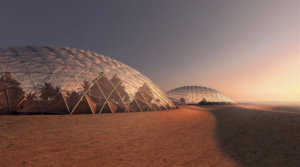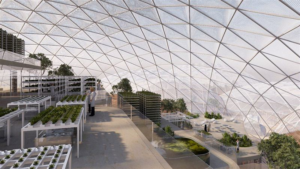UAE Looks to the Stars As It Launches Mars Science City Project, Complete with Labs and 3D Printed Museum Walls
 Ever since implementing its ambitious 3D Printing Strategy last year, Dubai has been focused on making the UAE a global 3D printing leader through the multi-tiered plan laid out in a directive by His Highness Sheikh Mohammad bin Rashid Al Maktoum, Vice-President and Prime Minister of the UAE and Ruler of Dubai. The city-state has been churning out 3D printing innovation in the medical field, in research and materials, and construction.
Ever since implementing its ambitious 3D Printing Strategy last year, Dubai has been focused on making the UAE a global 3D printing leader through the multi-tiered plan laid out in a directive by His Highness Sheikh Mohammad bin Rashid Al Maktoum, Vice-President and Prime Minister of the UAE and Ruler of Dubai. The city-state has been churning out 3D printing innovation in the medical field, in research and materials, and construction.
 The Dubai Municipality sector has been involved with the Dubai Future Accelerators program, and shares the 3D Printing Strategy’s goal of achieving 25% of all construction in Dubai through 3D printing. From the 3D printed R&Drone Laboratory and Office of the Future to a planned skyscraper and residential building, Dubai is making good on this goal. But now it’s got its eye on construction that is literally out of this world – Sheikh Mohammed bin Rashid and His Highness Sheikh Mohamed bin Zayed Al Nahyan, Crown Prince of Abu Dhabi and Deputy Supreme Commander of the UAE Armed Forces, are looking to the stars.
The Dubai Municipality sector has been involved with the Dubai Future Accelerators program, and shares the 3D Printing Strategy’s goal of achieving 25% of all construction in Dubai through 3D printing. From the 3D printed R&Drone Laboratory and Office of the Future to a planned skyscraper and residential building, Dubai is making good on this goal. But now it’s got its eye on construction that is literally out of this world – Sheikh Mohammed bin Rashid and His Highness Sheikh Mohamed bin Zayed Al Nahyan, Crown Prince of Abu Dhabi and Deputy Supreme Commander of the UAE Armed Forces, are looking to the stars.
 At today’s UAE annual government meeting in Abu Dhabi, the two officially launched the Mars Science City project, an AED 500 million city that will cover 1.9 million square feet: the largest space simulation city ever built. The project is looking to attract the best scientific minds from around the world, and will include agricultural testing, a museum with 3D printed walls, laboratories for water, food, and energy, and studies about future food security, offering a realistic model for living on Mars.
At today’s UAE annual government meeting in Abu Dhabi, the two officially launched the Mars Science City project, an AED 500 million city that will cover 1.9 million square feet: the largest space simulation city ever built. The project is looking to attract the best scientific minds from around the world, and will include agricultural testing, a museum with 3D printed walls, laboratories for water, food, and energy, and studies about future food security, offering a realistic model for living on Mars.
“The UAE seeks to establish international efforts to develop technologies that benefit humankind, and that establish the foundation of a better future for more generations to come. We also want to consolidate the passion for leadership in science in the UAE, contributing to improving life on earth and to developing innovative solutions to many of our global challenges,” said Sheikh Mohammed bin Rashid.
“The UAE is a great country with vision and understanding of the challenges we face and the rapid changes our world is experiencing. We believe in the potential of space exploration, and in collaborating with global partners and leaders in order to harness the findings of this research and movement that seeks to meet people’s needs and improve quality of life on earth.”
“The new project is another step in the UAE’s leading contributions to the global science movement; we seek to set an example and motivation for others to participate, and contribute, to humanity’s march into space.”
 A team from the Dubai Municipality and the Mohammed bin Rashid Space Centre will lead Emirati designers, engineers, and scientists in the project, in cooperation with top international architects Bjarke Ingels. Several domes will make up the city, and several innovative construction techniques, including 3D printing, will give the structures support. The museum, featuring 3D printed walls, will display the greatest space achievements of humanity, and have several educational areas that will engage youth with space, to inspire them to be passionate about discovery and exploration.
A team from the Dubai Municipality and the Mohammed bin Rashid Space Centre will lead Emirati designers, engineers, and scientists in the project, in cooperation with top international architects Bjarke Ingels. Several domes will make up the city, and several innovative construction techniques, including 3D printing, will give the structures support. The museum, featuring 3D printed walls, will display the greatest space achievements of humanity, and have several educational areas that will engage youth with space, to inspire them to be passionate about discovery and exploration.
“We have great confidence in our national work teams, and Emirates Mars Mission prove that our youth are trustworthy and capable of achieving national ambitions,” said Sheikh Mohamed bin Zayed.
The completed Mars Science City structure is on track to be the most sophisticated building in the world – sand from the Emirati desert will be used to 3D print the walls of the museum, and 3D printing technology, combined with heat and radiation insulation, will be used to build advanced laboratories that simulate the harsh environment and terrain of Mars.
The goal of the project is to incorporate a realistic, simulated environment that mimics the conditions you would find on the surface of the red planet; the effort will also address challenges we face in the world today, such as food, water and energy security. A team will live in the Mars Science City for one year as part of an experiential project element, in hopes of being used as an important reference in terms of sustaining life in a hostile environment. While there, the team will conduct multiple experiments that will hopefully lead to progress in self-sufficiency in energy, food and water around the world.
The Mars Science City project, which falls under the UAE’s objectives to lead the ongoing scientific race to get people to Mars, is part of its Mars 2117 Strategy, which was launched during the fifth World Government Summit and is working to build the first settlement on the planet of Mars in the next 100 years.
Discuss this and other 3D printing topics at 3DPrintBoard.com, or share your thoughts below.
[Source/Images: Dubai News]
Subscribe to Our Email Newsletter
Stay up-to-date on all the latest news from the 3D printing industry and receive information and offers from third party vendors.
You May Also Like
Precision at the Microscale: UK Researchers Advance Medical Devices with BMF’s 3D Printing Tech
University of Nottingham researchers are using Boston Micro Fabrication‘s (BMF) 3D printing technology to develop medical devices that improve compatibility with human tissue. Funded by a UK grant, this project...
3D Printing Webinar and Event Roundup: April 21, 2024
It’s another busy week of webinars and events, starting with Hannover Messe in Germany and continuing with Metalcasting Congress, Chinaplas, TechBlick’s Innovation Festival, and more. Stratasys continues its advanced training...
3D Printing Webinar and Event Roundup: March 17, 2024
It’s another busy week of webinars and events, including SALMED 2024 and AM Forum in Berlin. Stratasys continues its in-person training and is offering two webinars, ASTM is holding a...
3D Printed Micro Antenna is 15% Smaller and 6X Lighter
Horizon Microtechnologies has achieved success in creating a high-frequency D-Band horn antenna through micro 3D printing. However, this achievement did not rely solely on 3D printing; it involved a combination...































